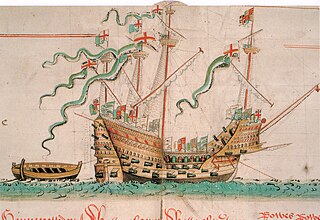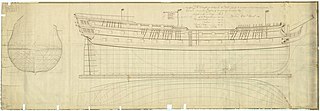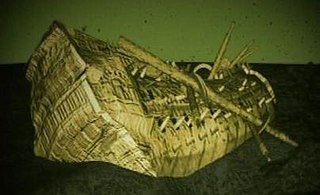
The Mary Rose was a carrack in the English Tudor navy of King Henry VIII. She was launched in 1511 and served for 34 years in several wars against France, Scotland, and Brittany. After being substantially rebuilt in 1536, she saw her last action on 19 July 1545. She led the attack on the galleys of a French invasion fleet, but sank in the Solent, the strait north of the Isle of Wight.

HMS Colossus was a 74-gun third-rate ship of the line of the Royal Navy. She was launched at Gravesend on 4 April 1787 and lost on 10 December 1798. During her years of service she participated in the Battle of Groix, the Battle of Cape St Vincent, and the Battle of the Nile. While carrying wounded from the latter, she was wrecked at the Isles of Scilly. The wreck is a Protected Wreck managed by Historic England.

HMS Victory was a 100-gun first-rate ship of the line of the Royal Navy, built to the dimensions of the 1733 proposals of the 1719 Establishment at Portsmouth Dockyard, and launched on 23 February 1737.

HMS Resolution was a 70-gun third-rate ship of the line of the Royal Navy, launched at Harwich Dockyard on 6 December 1667. She was one of only three third-rate vessels designed and built by the noted maritime architect Sir Anthony Deane.

The Salcombe Cannon wrecksite is close to two other designated wrecksites in the Erme Estuary which the South West Maritime Archaeological Group (SWMAG) was licensed to investigate. In 1992 this group described the Salcombe Cannon site as:
Cattewater Wreck is a wooden three-masted, skeleton-built vessel, one of many ships that have wrecked in Cattewater, Plymouth Sound, England. This wreck is close to the entrance of Sutton Harbour, its name is still unknown but it is believed to be from the 16th century. It is a Protected Wreck managed by Historic England.

London was a 76-gun second-rate ship of the line in the Navy of the Commonwealth of England, originally built at Chatham Dockyard by shipwright John Taylor, and launched in June 1656. She gained fame as one of the ships that escorted Charles II from Holland back to England during the English Restoration, carrying Charles' younger brother James Duke of York, and commanded by Captain John Lawson.

Dunwich is a village and civil parish in Suffolk, England. It is in the Suffolk Coast and Heaths AONB around 92 miles (148 km) north-east of London, 9 miles (14 km) south of Southwold and 7 miles (11 km) north of Leiston, on the North Sea coast.
The Swash Channel Wreck is the remains of an early 17th-century armed merchantman possibly of Dutch origin wrecked outside of Poole Harbour. The vessel was approximately 40 m long and has been predicted to be around 600 tonnes. The ship was probably involved with the beginning of internationalization.
Mars, also known as Makalös, traditionally referred to as Jutehataren, was a Swedish warship that was built between 1561 and 1563. She was the leading ship of King Eric XIV of Sweden's fleet and was one of the largest warships of the time. In 1564, during the Northern Seven Years' War, she caught fire and exploded during the First battle of Öland in the Baltic Sea.

The Streedagh Armada wrecksite is the site of three shipwrecks of the Spanish Armada at Streedagh beach in north County Sligo, in northwest Ireland. The three ships are La Lavia, La Juliana, and the Santa Maria de Visón. All were part of the Levant squadron of the armada. The Lavia was the almiranta, or vice flagship of the fleet and carried the Judge Advocate General, Martin de Aranda, responsible for the discipline of the armada.
The Hazardous, formerly Le Hazardeux, was a French third-rate ship of the line captured by the English and later sunk in Bracklesham Bay, West Sussex. The wreck was found in 1977. The site was designated under the Protection of Wrecks Act on 21 August 1986. The wreck is a Protected Wreck managed by Historic England.
The Bartholomew Ledges Wreck is a wreck found in the late 1970s at St Marys Sound, Isles of Scilly is believed to be that of a mid-sixteenth to early seventeenth century armed cargo vessel. The site was designated under the Protection of Wrecks Act on 23 September 1980. The wreck is a Protected Wreck managed by Historic England.
The Erme Estuary wreck is a shipwreck site containing the remains of potentially more than one wreck that was discovered in 1990 on Mary Reef in the Erme Estuary in Dorset. The site was designated under the Protection of Wrecks Act on 1 May 1991. The wreck is a Protected Wreck managed by Historic England.
The Gull Rock Wreck was discovered off Gull Rock, Lundy Island, England in 1968. The site was designated under the Protection of Wrecks Act on 12 February 1990. The wreck is a Protected Wreck managed by Historic England.
The Chesil Beach cannon consists of the remains of an unknown wreck were found on Chesil Beach, Dorset, England in 2010. The site was designated on 18 July 2017. The wreck is a Protected Wreck managed by Historic England.
The remains of an apparent armed wooden sailing vessel were identified in 2010 on The Downs, Kent, England. The site was designated under the Protection of Wrecks Act on 3 August 2012. The wreck is a Protected Wreck managed by Historic England.
The Tearing Ledge Wreck consists of the remains of a ship, possibly one of the ships belonging to Admiral Cloudisley Shovell's fleet of 21 vessels returning from the Siege of Toulon via Gibraltar, that were found in 1969 on Tearing Ledge, Western Rocks, Isles of Scilly. The site was designated under the Protection of Wrecks Act on 12 February 1975. The wreck is a Protected Wreck managed by the National Heritage List for England.
The remains of a seventeenth century cargo vessel were identified in Gunwalloe fishing cove, Cornwall in 1998. The site was designated under the Protection of Wrecks Act on 23 May 1999. The wreck is a Protected Wreck managed by Historic England.

The Rill Cove Wreck is an underwater wreck of a 16th-century Spanish cargo ship lying off the coast of Rill Cove, west of Kynance Cove, in Cornwall, England, UK.








